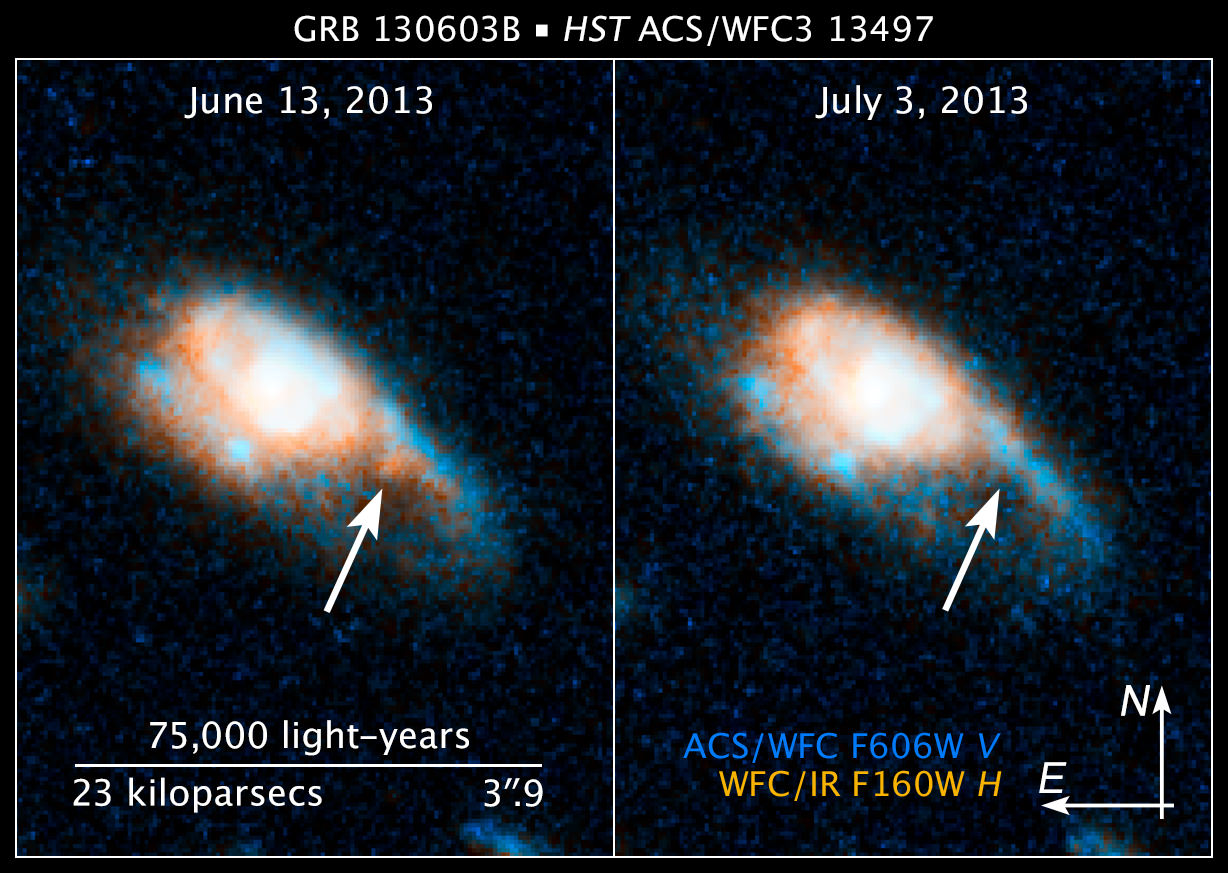As astute readers of Universe Today, you likely know what a supernova is: a stellar explosion that signals the end game for certain kinds of stars. Above, however, is a picture of a kilonova, which happens when two really dense objects come together.
This fireball arose after a short-term (1/10 of a second) gamma-ray burst came into view of the Swift space telescope on June 3. Nine days later, the Hubble Space Telescope looked at the same area to see if there were any remnants, and spotted a faint red object that was confirmed in independent observations.
It’s the first time astronomers have been able to see a connection between gamma-ray bursts and kilonovas, although it was predicted before. They’re saying this is the first evidence that short-duration gamma ray bursts arise as two super-dense stellar objects come together.
So what’s the connection? Astronomers suspect it’s this sequence of events:
- Two binary neutron stars (really dense stars) start to move closer to each other;
- The system sends out gravitational radiation that make ripples in space-time;
- These waves make the stars move even closer together;
- In the milliseconds before the explosion, the two stars “merge into a death spiral that kicks out highly radioactive material,” as NASA states, with material that gets warmer, gets bigger and sends out light;
- The kilonova occurs with the detonation of a white dwarf. While it’s bright, 1,000 times brighter than a nova, it’s only 1/10th to 1/100th the brightness of an average supernova.

“This observation finally solves the mystery of the origin of short gamma ray bursts,” stated Nial Tanvir of the University of Leicester in the United Kingdom, who is also the lead author.
“Many astronomers, including our group, have already provided a great deal of evidence that long-duration gamma ray bursts (those lasting more than two seconds) are produced by the collapse of extremely massive stars. But we only had weak circumstantial evidence that short bursts were produced by the merger of compact objects. This result now appears to provide definitive proof supporting that scenario.”
Check out more details on the burst on HubbleSite. The scientific paper associated with these results was published in Nature Aug. 3.
Source: NASA


Very interesting set of events. The information gathered from both Swift and Hubble will go a long way towards adding more evidence to short gamma ray bursts and Kilonova in general. Very cool!
Here’s the relevant and free paper (PDF) by the above mentioned author:
A search for kilonova emission associated with GRB 130603B: the smoking gun signature of a compact binary merger event.
This article makes no sense. How do we start with two neutron stars, and end up with an exploding white dwarf?!
The original HubbleSite NASA news release states:
Apparently, the author messed up when writing the article in her own words!
I see no mess-up on the author’s part. Nova<kilonova<supernova.
But I DO see some backwards reasoning in the statement that the gravity waves "… make the two stars move even closer together."
Is it not that the orbital decay of the two stars causes the gravity waves? Stated correctly, it is the stars that are dissipating energy into and driving the gravity waves.
I seem to see a disappointing degree of such backwards reasoning from today's scientists. Probably I simply was born too early.
What happened to my message?????????
lol i was trying to find some logic behind all those =,” and the words in alphabetical order xD. But hey the last line looks like html code maybe you messed up the code with your ><.
I used only the “less than” symbol, and both of those, and the associated text, were properly placed. Therefor it’s difficult to verify your theory, but still your theory seems to be the only plausible explanation.
Now, let’s see if THIS message gets through.
Thanks, Soda. Are you a moderator here? If not, are they asleep?
What I had intended to say I will try again.
The point made by the author with which I disagree is that the gravity waves did not cause the starts to converge. It is the dissipation of orbital energy of the stars that creates the gravity waves. I further asked, rhetorically I guess, why we see backwards reasoning like this from scientists these days – or is it just from science writers?
You see no mess-up in: “Step 1: Two neutron stars” leading to “Step 5: …detonation of a white dwarf”? IVAN3MAN found the author’s error of confusing the cause of an ordinary nova with that of a kilonova.
As for “gravity waves causing the stars to move together,” I agree it could have been worded better, but it’s essentially correct, in that conservation of energy dictates that energy (in the form of gravitational waves) radiated from the system has to come from somewhere (the orbital energy of the neutron stars).
You have made my point. It is the energy of the bodies in motion being disipated through the gravitational waves into space. It is NOT the gravitational waves *causing* the bodies to converge.
It seems that some can’t make this distinction. To me it is as absolute as the arrow of time.